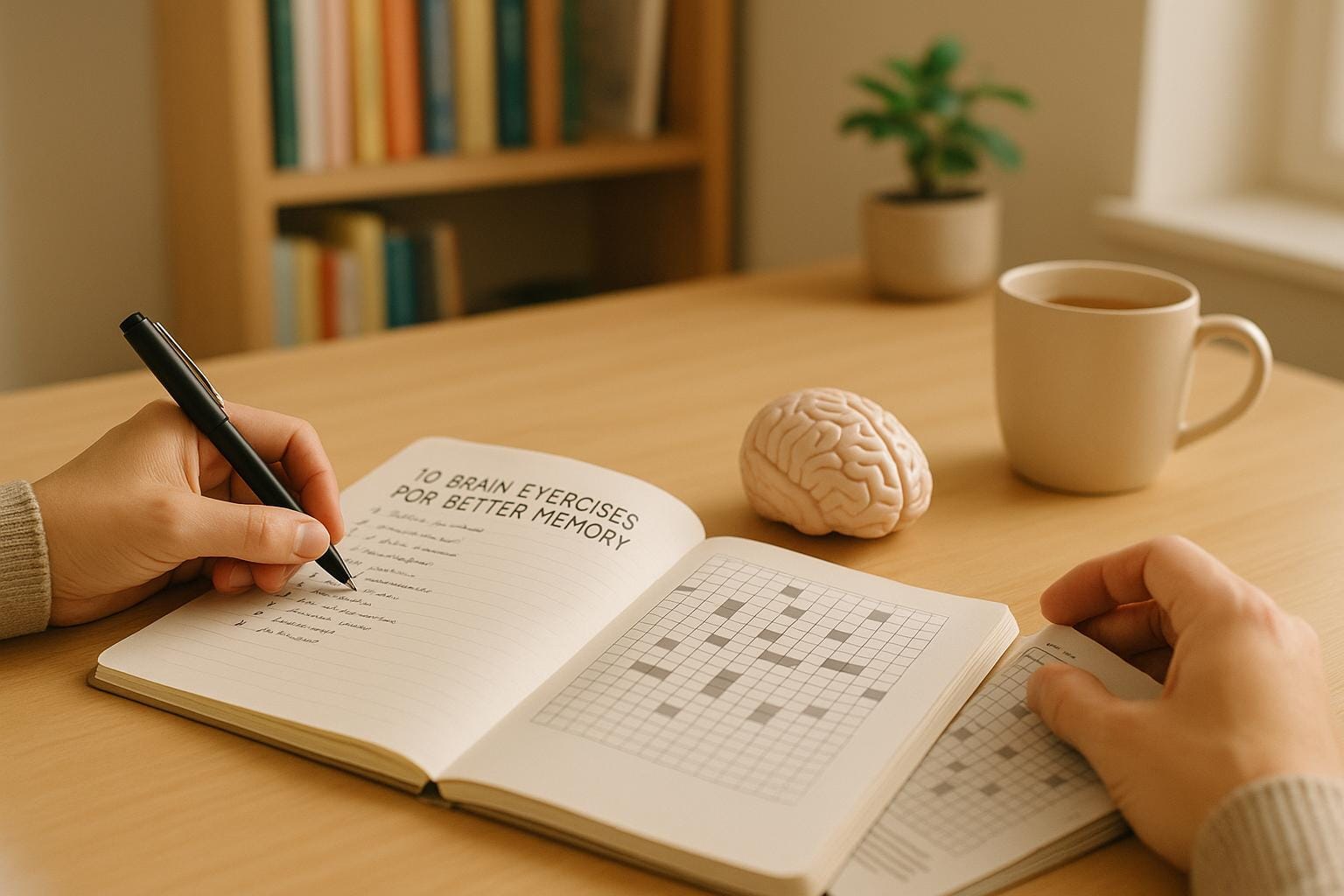Your brain isn’t built for constant multitasking. Deep work and time blocking are two strategies that help you focus, avoid distractions, and get more done in less time. Here's how they work:
- Deep Work: Focus on one demanding task without interruptions. This improves your skills, creates high-impact results, and strengthens your brain's focus networks.
- Time Blocking: Plan your day in advance by assigning specific time slots to tasks. This reduces decision fatigue and aligns with your brain's natural focus cycles.
Why It Works:
- Multitasking reduces productivity by 40% and can take over 20 minutes to regain focus after interruptions.
- Your brain thrives in 90-minute focus cycles and needs breaks to recharge.
- Chemicals like dopamine and acetylcholine boost focus and motivation during deep work.
Quick Tips:
- Schedule tough tasks during peak energy hours.
- Work in 60-90 minute blocks, followed by short breaks.
- Eliminate distractions (turn off notifications, clear your workspace).
- Plan your day the night before to avoid decision fatigue.
By combining deep work and time blocking, you can work smarter - not harder - while reducing stress and mental overload.
The Neuroscience of Deep Work - Dr. Andrew Huberman
The Science Behind Deep Work: How Focus Affects Your Brain
Engaging in deep work triggers profound changes in your brain, enhancing focus and cognitive processing. On a neurological level, sustained attention activates interconnected brain networks and releases key chemicals that optimize your mental performance.
How Deep Work Boosts Brain Function
Deep work isn't just about pushing through distractions - it's about tapping into your brain's natural chemistry to reach peak performance. When you concentrate deeply, your brain releases three critical chemicals: acetylcholine, dopamine, and norepinephrine. Each plays a unique role: acetylcholine sharpens your focus, dopamine keeps you motivated, and norepinephrine helps you stay alert and engaged.
But the benefits don't stop there. Deep focus strengthens the connections between neurons, helping to solidify learning and improve skills over time. Think of it as a workout for your brain - each session builds mental strength and resilience.
Specific brain regions also come into play during deep work. For instance, attention activates areas like the prefrontal cortex and striatum. Problem-solving and reasoning engage the frontoparietal network, particularly the intraparietal sulcus. If you're processing language or tackling verbal reasoning, regions such as the frontal operculum, posterior temporal lobe, superior parietal lobe, and both dorsal and ventral prefrontal cortices light up.
Interestingly, focus isn't controlled by one single brain region. Instead, it relies on a coordinated effort between neuromodulators across multiple networks. However, there's a catch: as we age, acetylcholine levels naturally decline, making it harder to maintain focus and learn new skills. This underscores the importance of treating your attention as a limited resource and allowing time for recovery. On the flip side, constantly switching tasks can lead to harmful neurochemical responses that undermine your performance.
The Cost of Constant Task-Switching
While deep work strengthens your brain, frequent task-switching does the opposite. Jumping between tasks forces your brain to work against its natural design, and the consequences are significant.
Switching tasks repeatedly spikes cortisol levels and depletes glucose - the brain's primary energy source - leading to stress, fatigue, and reduced efficiency. In fact, context switching can slash productivity by up to 40%, and multitasking can lower IQ scores by as much as 15 points.
"Every single time we switch there is a cost. It's draining. It's taking longer to do the same thing."
– Dr. Sahar Yousef, Cognitive Neuroscientist, UC Berkeley
Heavy multitasking doesn't just hurt productivity - it can physically alter your brain. Studies show it reduces gray matter in areas responsible for attention. It also weakens memory, shortens your attention span, increases errors, and can make tasks take up to 50% longer to complete.
The economic toll is staggering, too. Multitasking-related productivity losses cost the global economy an estimated $450 billion every year. As Cal Newport aptly points out:
"Managers spend 85% of the day in meetings, on the phone or talking to people about work, not doing it. It's flexible and adaptive, but conflicts with the way that the human brain operates. Those context shifts are devastating and burn you out."
Our brains simply aren't wired for multitasking. Once you understand how deeply task-switching disrupts cognitive function, the importance of protecting your deep work time becomes crystal clear. Your brain thrives when you align your work habits with its natural rhythms.
This article is for informational purposes only and is not intended as medical advice. Please consult a healthcare professional before starting any new fitness or wellness routine.
Time Blocking: Working with Your Brain's Natural Rhythms
Time blocking isn’t just about organizing your day - it’s about syncing with your brain’s natural tendencies. By planning your schedule around how your brain works best, you can unlock higher productivity and avoid unnecessary mental strain.
Your Brain’s 90-Minute Focus Cycles
Your brain runs on predictable patterns called ultradian rhythms, which typically last between 90 and 120 minutes. These cycles act as a natural timer for peak mental performance. Research shows it takes about 40 to 50 minutes to get fully engaged in a task, and working in focused sessions of 60 to 90 minutes often delivers the best results.
Pushing beyond this natural limit can backfire. Concentration drops, mistakes increase, and mental fatigue sets in.
Cal Newport describes this balance well:
"You need the sweet spot in between the relentless but sustainable pace. I'm continuing to work on this, but giving it my full attention when it gets my attention. But not too much time, spread out over time, that's where good stuff emerges."
After each focus session, a break of 10 to 30 minutes helps reset your mind and recharge your ability to dive back into deep work. Start small with 30- to 45-minute focus blocks and gradually extend them as you build stamina. Honoring these natural cycles not only sharpens your focus but also minimizes the exhaustion that comes from constant decision-making.
How Time Blocking Reduces Decision Fatigue
Time blocking doesn’t just align with your brain’s cycles - it also saves mental energy by cutting down on decision fatigue. Every choice you make throughout the day chips away at your cognitive resources. By pre-planning your schedule, you eliminate the need to constantly decide what to do next, preserving your mental energy for more challenging tasks.
When your day isn’t planned, your brain wastes energy switching between decisions, which can drain focus and productivity. Studies show that frequent context switching can lower efficiency by over 15%. On the flip side, single-tasking - focusing on one thing at a time - can boost productivity by up to 40%. Time blocking lets you assign specific tasks to dedicated time slots, helping your brain concentrate fully on one thing at a time.
Here’s a simple way to get started: spend 15 minutes at the start of your day (or the night before) planning your time blocks. Look over your to-do list and estimate how many focused sessions each task will take. If a task seems like it’ll take more than five sessions, break it into smaller, more manageable steps. Group similar tasks - like answering emails - into a single block to streamline your workflow.
This approach not only keeps your day organized but also helps your brain stay sharp for tougher challenges. With a clear plan in place, your mind knows what’s coming next, making transitions between tasks smoother and less taxing.
This article is for informational purposes only and is not intended as medical advice. Please consult a healthcare professional before starting any new fitness or wellness routine.
How Focused Work Reduces Mental Overload
Tapping into the neuroscience behind deep work, it becomes clear that your brain has a limited capacity for juggling tasks. Multitasking often falls short, while strategies like deep work and time blocking help you stay clear-headed and productive.
Working Memory Limits and Why They Matter
Your working memory acts like a temporary mental workspace - it’s where you hold and process information while tackling tasks. But here’s the catch: this workspace is surprisingly small. Most people can only juggle about four pieces of information at once. Push past this limit, and you risk cognitive overload. When you switch tasks, your brain has to reload information repeatedly, which can slash productivity by up to 40%.
Overloading your working memory can lead to mental fatigue, poor focus, and bad decision-making. Unfortunately, multitasking is a common culprit - 40% of adults regularly multitask with digital devices, which not only increases stress but also hampers productivity. To work within your brain’s natural limits, try turning off notifications during focus sessions, keeping your workspace clutter-free, and using tools like checklists or project dashboards to offload mental tasks. In short, managing your working memory is all about prioritizing single-task focus.
Why Single-Task Focus Works Better
The solution to working memory overload isn’t about expanding its capacity - it’s about using it wisely. Single-tasking, supported by time blocking, allows your brain to direct its full attention to one task at a time. This approach reduces mistakes, speeds up task completion, and enhances comprehension. Without the constant need to shift gears, you can work more efficiently and effectively.
Time blocking is a natural fit for single-tasking. For instance, reserving a 90-minute block solely for writing a report helps you avoid distractions like emails or messages. This kind of focused work not only boosts productivity but also improves your ability to learn and retain information.
Cal Newport, an advocate of this method, explains:
"I'm not a big believer in to-do lists. I like to grapple with the actual available time. Like, okay, I have a meeting here, I have to pick my kids up from school here. Here's the actual hours of the day that are free and where they fall."
This "time-first" mindset encourages you to realistically evaluate what you can accomplish in a day, cutting down the number of tasks vying for your attention. Instead of being overwhelmed by a long to-do list, you work within defined time blocks that respect your brain’s limits.
To make this work for you, identify your most mentally demanding tasks and schedule them during your peak energy hours. Activate "Do Not Disturb" on your devices, close unnecessary browser tabs, and let others know when you’re in a focus block. These small tweaks can significantly improve your ability to stay on task and avoid overloading your working memory. By embracing deep work and time blocking, you align your efforts with how your brain works best.
This article is for informational purposes only and is not intended as medical advice. Please consult a healthcare professional before starting any new fitness or wellness routine.
How to Use Deep Work and Time Blocking in Daily Life
Understanding the science behind deep work is one thing, but putting it into practice is where the magic happens. This guide will help you turn scattered days into focused, productive sessions by scheduling tasks wisely, optimizing your workspace, and planning effective breaks.
Schedule Hard Tasks During Your Peak Hours
Your brain doesn’t function at the same level all day long. To figure out when you’re at your best, try keeping an energy journal for a week or two. Track your focus, energy levels, and the times when you feel the need for breaks. This can help you identify patterns and pinpoint your peak productivity hours. Research suggests that most people perform their best during a three-hour window in the morning, but your chronotype - whether you’re a morning person or a night owl - plays a big role in determining when you hit your stride.
Once you know your peak hours, guard them carefully. Use this time to tackle your most challenging tasks, such as writing, strategic planning, or problem-solving. Aim for 90-minute blocks of focused work during these optimal hours. To keep your energy steady, consider meals that avoid spikes and crashes.
"Typically, we have a window of about three hours where we're really, really focused. We're able to make strong contributions in terms of planning, thinking, and speaking well."
– Rod Friedman
After scheduling your tasks, set up an environment that supports your ability to concentrate.
Set Up Your Space for Deep Work
Your surroundings can make or break your ability to focus. For instance, clutter can increase cortisol levels, the stress hormone that interferes with decision-making and concentration. Keep your workspace clean and organized, and use tools like desk organizers to keep distractions out of sight. Digital distractions are another hurdle - close unnecessary browser tabs and put your phone away to stay on track.
"Your personal workspace is one of the most overlooked factors that affect productivity."
– Jamie Fertsch, director and co-founder of Xdesk
Lighting also plays a big role in focus. Natural light has been linked to better mood and energy, with studies showing an 18% boost in productivity for those with access to outdoor views. If you’re stuck in a windowless space, daylight-simulating LEDs can create a similar effect. Even adding a single potted plant to your desk can improve reaction times by 12% and creativity by 15%.
Noise is another factor to consider. In open offices or noisy environments, ambient sounds can increase stress and disrupt focus. Noise-canceling headphones, white noise machines, or sound-absorbing materials can help create a quieter workspace. As Lucy Milligan Wahl, owner of LMW Edits, explains:
"Any kind of discomfort, from the ergonomics of a desk to the noise level in a space, affects our ability to focus and be productive."
Finally, ergonomic furniture can do more than just keep you comfortable - it reduces physical strain, helping you maintain focus and energy throughout the day.
Once your workspace is optimized, the next step is to plan breaks that keep you productive.
Plan Your Breaks to Stay Productive
Taking regular breaks is key to maintaining focus over long periods. Since concentration naturally fades, scheduling breaks before you feel drained can help you stay sharp. Most people can focus intensely for 40–90 minutes before their efficiency starts to drop, so it’s smart to build regular, non-negotiable breaks into your day.
"Time blocking minimizes these switches, helping maintain cognitive efficiency and reducing mental fatigue."
– Dr. Zishan Khan, Board-Certified Psychiatrist, Mindpath Health
Short breaks - like stepping away from your desk, looking out a window, or watching a calming nature video - can quickly reset your mind. For longer breaks, try activities that engage different parts of your brain, such as walking, meditating, or light exercise.
Techniques like the Pomodoro Technique can help structure your work and break times. While the exact timing may vary from person to person, the principle is simple: alternating focused work with planned recovery boosts the overall quality of your attention. Even small movements, like stretching or walking, during breaks can increase blood flow to the brain and help you return to work refreshed.
The goal isn’t to work nonstop - it’s to align your work habits with your brain’s natural rhythms for better focus and productivity.
This article is for informational purposes only and is not intended as medical advice. Please consult a healthcare professional before starting any new fitness or wellness routine.
Conclusion: Using Brain Science to Work Better
Neuroscience reveals that deep work and time blocking are in sync with how your brain naturally functions, enhancing both clarity and productivity.
These two strategies complement each other perfectly. Time blocking provides the structure you need to focus, while deep work fills those blocks with meaningful, high-impact tasks. Together, they streamline your workflow and help conserve your mental energy.
Research shows that focusing on one task at a time during time-blocked deep work sessions can increase productivity by as much as 40% compared to multitasking. Additionally, interruptions can derail your focus, often taking more than 20 minutes to regain your momentum. This makes it essential to protect your concentration.
"A 40 hour time-blocked work week, I estimate, produces the same amount of output as a 60+ hour work week pursued without structure." – Cal Newport, Author of Deep Work
Your brain operates in natural focus cycles of 90–120 minutes, with limited working memory and attention. Time blocking respects these cycles by carving out specific windows for demanding tasks, while deep work ensures those windows are distraction-free and laser-focused. This approach not only optimizes your brain's capacity but also reduces mental strain.
Another benefit? It minimizes decision fatigue. Instead of constantly deciding what to tackle next, you make those choices during your planning session, preserving your mental energy for what truly matters. By aligning your schedule with your brain's rhythms, you can work smarter, not harder.
"Deep work is a superpower; in today's economy, it is becoming increasingly rare and increasingly valuable." – Cal Newport
Start small: try one or two time-blocked deep work sessions during your most productive hours. As your ability to focus improves, you can gradually extend these sessions and add more blocks to your routine.
The goal isn’t to work longer - it’s to work better. By syncing your habits with your brain’s natural patterns, you can achieve more meaningful results while avoiding unnecessary stress and fatigue.
This article is for informational purposes only and is not intended as medical advice. Please consult a healthcare professional before starting any new fitness or wellness routine.
FAQs
How can I find my most productive hours for deep work and time blocking?
To figure out when you're at your best during the day, start by paying attention to your energy levels and focus. For one week, jot down when you feel sharp and when it's harder to stay on task. This simple habit can reveal patterns in your productivity.
Another option is to use productivity tracking tools or apps to get a clearer picture of your work habits. Once you know your peak hours, plan your most challenging tasks for those times. Aligning your toughest work with your natural energy highs can boost both your efficiency and mental sharpness.
How can I reduce distractions and stay focused during deep work sessions?
To stay focused during deep work, start by blocking out specific time slots for concentrated effort. Treat these blocks as unmissable appointments, giving them the same importance as meetings or deadlines. This helps you build a habit and ensures your key tasks get the attention they deserve.
Next, set up a workspace that minimizes distractions. Choose a quiet area, use noise-canceling headphones if needed, and keep your desk clear of clutter. On the digital side, silence notifications and use apps or browser extensions to temporarily block distracting websites.
Lastly, work in sync with your brain's natural rhythms. Break your tasks into 90-120 minute sessions, followed by short breaks. This method helps you stay mentally sharp and productive throughout the day.
How does time blocking reduce decision fatigue and boost productivity?
Time blocking is a powerful way to cut down on decision fatigue and boost productivity. By assigning specific tasks to set time slots, you remove the constant need to figure out what to work on next. This not only saves mental energy but also leaves you with more brainpower for bigger, more important choices.
Another benefit? It helps you zero in on one task at a time. With fewer distractions and less mental juggling, you can work more effectively without the strain of switching between tasks. Plus, time blocking encourages you to prioritize, making it easier to tackle your most critical tasks when your energy and focus are at their peak.












